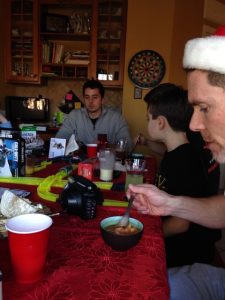(7/15/19)
For this study, I have chosen my Aunt Barbarina’s kitchen table. My Aunt “Babs” lives in Gainesville, Virginia with her husband (Uncle Dan) and two kids (Alexandria and Sean). Using the examples of anthropological methods from our reading, Eating Culture An Anthropological Guide to Food, I have chosen two anthropological methods as tools for this kitchen table analysis: an (over the phone) structured interview and my past participant observations. The reason I have chosen an over-the-phone interview is simply the logistical fact that my Aunt Babs lives 1000 miles away. Therefor, I am not able to physically be in the kitchen observing them at this particular moment. However, I can rely on both this structured interview and my previous observations while visiting their home numerous times in the past. I know their kitchen as well as my own.
The kitchen area is in the main part of their house. It connects to other areas such as the family room, the welcome area, the bedrooms, and the stairs to the basement. Walking into the house, one can almost immediately observe the kitchen area, if not already lead there by the glorious smells emanating therein. During my interview, Aunt Babs informed me that they spend more time together in the kitchen than in any other part of their house, and of course as in any room, there is a common focal point for gathering.
Within this kitchen, there is a special kitchen table, a table that has been around for over two decades. Some people might see this table as a mere uni-dimensional table, but my Aunt Babs has explained to me in our interview that it is far more multi-dimensional. It represents her familial bonding area. Not only is their kitchen table used for consuming delicious meals, it is also used for much more. Aunt Babs explained that their kitchen table serves as a communication hub, work hub, celebration hub, and everything in between. Their kitchen table basically serves as a life hub.
The delicious smells from her kitchen are indelibly imprinted in my mind. I have observed on numerous occasions walking into Aunt Babs’s kitchen for a Christmas dinner and smelling all of the unique, mouth-watering scents that permeated the whole house. Watching my family cook was quite a sight to see. There were many chefs in this kitchen, all working on different parts of the meal, truly performing like a symphony. This is one case where there were never too many chefs in this kitchen. Despite having adequate counter space, many of the chefs gravitated to that same, special kitchen table to prepare their portion of the meal masterpiece. Food preparation was a family bonding moment because one could observe the collaboration and communication of several generations of family members. Once the meal was properly prepped, the younger generation would set this same table with utensils, drinking glasses and place-mats. In my observation from preparation to presentation to consumption, this same table was truly multitasking.
Aunt Babs told me that her kitchen table serves as a communication area for their family to have tough discussions as well as simple, casual conversations. She revealed that when her family goes through hard times, the kitchen table serves as a place to discuss and hopefully resolve conflicts. As a younger child, my cousins and I would always be drawn back to the kitchen table after hours of play in the basement, our families still sitting at that same kitchen table long after the food had been consumed. Loud bursts of laughter continued well into the night. Who would have thought that the kitchen table would be a popular venue for standup comedy. Aunt Babs also explained that whenever their neighborhood friends come to visit, the majority of the time is spent at that same kitchen table, catching up on all things good and bad. She was quick to point out that even though this table was within their home, it has been a decidedly effective communication hub with the outside world as the family gathers around for FaceTime or phone call conversations to the rest of the world. Not to be a coincidence, this FaceTime structured interview occurred with her sitting right at that very same kitchen table.
The kitchen table also serves as a “work station” on which my relatives do homework and school projects or for my Aunt Babs’s preparing business proposals for her company. During my internship with her this past summer, I knew this table well as she mentored me in the various aspects of running her company. My observation was that quite a lot of work can be done on a proper kitchen table with a cup of tea and some fresh biscottis.
Their kitchen table also serves as a celebration center. When they celebrate birthdays, special events such as a high school graduation, or other holidays such as Christmas, they spend most of their time celebrating in the kitchen area. For example, I observed in previous Easters, my cousins would use the kitchen table to dye Easter eggs and make an Easter bunny cake.

(My cousin, Alex, opening her graduation present (stethoscope) at the kitchen table)

(An early morning Christmas breakfast at the kitchen table)

(A family picture with Alex, Noni, and myself sitting at the kitchen table)
Aunt Babs’s family and extended family have a very special connection to her kitchen table. My cousins have lived in that same house with that same table for their entire lives. All of the scratches and dings represent far more than just blemishes on this table, the represent historical life events… the equivalent of carbon dating their lives. Aunt Babs explained to me there are so many amazing and unique life memories from every defect on that table. While it bares witness to many of our life’s ups and downs, fortunately most were up, and despite all of these years, it still stands strong. The kitchen table has become a part of their own family, and while they could have replaced it long ago, it just would not be the same.
From my personal experience, past observations and this recent interview, I used to believe that the warm atmosphere around this kitchen table was from the huge windows bringing in amiable sunlight or perhaps the soft chairs around the big wooden table. But using the anthropological methods described above, I recognized that this table is much more. It is a communication hub, it is a work station, it is a celebration center; it is all of these things and more. It is, as Aunt Babs said, a life hub!
Aunt Babs emphasized that the kitchen table was about unconditional love, love of life, love of family and friends, love of work. Based on this structured interview and my observations, both present and historical, I can unconditionally confirm that Aunt Babs’s table is all of these things, truly multidimensional.
References:
Eating Culture An Anthropological Guide to Food by Gillian Growther
